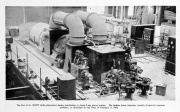Acton Lane Power Station


of Willesden
1899 built by the Metropolitan Electric Supply Co Limited.
Originally called Willesden Power Station; the station was later known as Acton Lane to distinguish it from another station called Willesden power station at Taylors Lane.
1912 A correspondent to The Times identified the Willesden Junction station as one of 6 which should be considered for bulk supply in an integrated London network; it generated 2 phase 60 Hz 10kV, with AC distribution at 100V and 200V[1].
1924 Purchased from Metropolitan Electric Supply Co together with main transmission lines by the London Electricity Joint Committee[2]
1925 This was one of four stations (the others being Bow, Deptford East and Grove Road, St John's Wood) which continued in operation following the formation of the London and Home Counties Joint Electricity Authority in 1925; many other, smaller stations in central London were closed.
1950 Construction of Acton Lane 'B' station began; it had three concrete cooling towers and dominated the eastern end of North Acton trading estate at Park Royal. Initial capacity was 56 MW.
c.1963 After a programmed reduction in capacity, the 'A' station finally closed
1983 The station closed; at the time its generating capacity was 150 MW.

